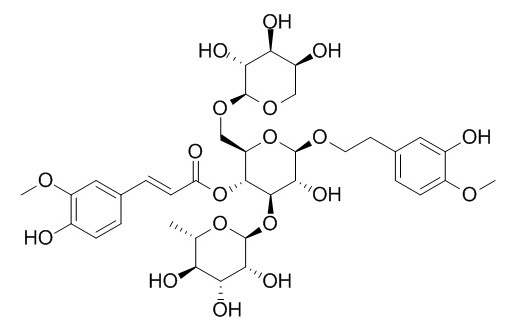Angoroside C
Angoroside C has anti-inflammatory effect , it can significantly inhibit LPS-induced PGE(2), NO and TNF-alpha in a concentration-dependent manner; it also exhibits cytotoxic and cytostatic activities against several kinds of cancer cells. Angoroside C has beneficial effects against ventricular remodeling, the mechanism is likely to be related to decreasing the level of Ang Ⅱ, attenuating the mRNA expressions of ET-1 and TGF-β1.
Inquire / Order:
manager@chemfaces.com
Technical Inquiries:
service@chemfaces.com
Tel:
+86-27-84237783
Fax:
+86-27-84254680
Address:
1 Building, No. 83, CheCheng Rd., Wuhan Economic and Technological Development Zone, Wuhan, Hubei 430056, PRC
Providing storage is as stated on the product vial and the vial is kept tightly sealed, the product can be stored for up to
24 months(2-8C).
Wherever possible, you should prepare and use solutions on the same day. However, if you need to make up stock solutions in advance, we recommend that you store the solution as aliquots in tightly sealed vials at -20C. Generally, these will be useable for up to two weeks. Before use, and prior to opening the vial we recommend that you allow your product to equilibrate to room temperature for at least 1 hour.
Need more advice on solubility, usage and handling? Please email to: service@chemfaces.com
The packaging of the product may have turned upside down during transportation, resulting in the natural compounds adhering to the neck or cap of the vial. take the vial out of its packaging and gently shake to let the compounds fall to the bottom of the vial. for liquid products, centrifuge at 200-500 RPM to gather the liquid at the bottom of the vial. try to avoid loss or contamination during handling.
Jurnal Ilmu Pertanian Indonesia2023, 28(4):525-533.
Separations2021, 8(6),80.
Nat Commun.2023, 14(1):5075.
Appl. Sci. 2021, 11(17),7829
J AOAC Int.2023, 106(1):56-64.
Cell.2018, 172(1-2):249-261
Applied Biological Chemistry2022, 65(85).
Cell Death Discov.2023, 9(1):350.
Agriculture2022, 12(12), 2173.
Pharmaceuticals (Basel).2024, 17(4):442.
Related and Featured Products
Life Sci. 2004 Apr 2;74(20):2515-26.
Phenylpropanoid glycosides from Scrophularia scorodonia: in vitro anti-inflammatory activity.[Pubmed:
15010262]
Five phenylpropanoid glycosides isolated from Scrophularia scorodonia L. (Scrophulariaceae), namely angoroside A (1), Angoroside C (2), angoroside D (3), acteoside (4) and isoacteoside (5), had been evaluated as potential inhibitors of some macrophage functions involved in the inflammatory process.
METHODS AND RESULTS:
These compounds have been tested in two experimental systems: ionophore-stimulated mouse peritoneal macrophages and human platelets serve as source of COX-1 and 5-LOX, and mouse peritoneal macrophages stimulated with E. coli LPS are the means of testing for COX-2, NO and TNF-alpha activity. None of compounds assayed had a significant effect on LTC(4)-release from calcium ionophore-stimulated mouse peritoneal macrophages. However, the release of PGE(2) by mouse peritoneal macrophages stimulated with calcium ionophore was inhibited by most of these compounds. In the TXB(2)-release assay, acteoside (4), angoroside A (1) and Angoroside C (2) showed a significant effect. These five compounds, except Angoroside C (2) significantly inhibited LPS-induced PGE(2), NO and TNF-alpha in a concentration-dependent manner. In LPS-stimulated macrophages, the phenylpropanoid glycoside Angoroside C (2) only had activity on NO.
CONCLUSIONS:
These results indicate that the pharmacology of these compounds may participate in the anti-inflammatory effect of Scrophularia scorodonia.
Phytomedicine. 2015 Jul 15;22(7-8):705-12.
The effect of angoroside C on pressure overload-induced ventricular remodeling in rats.[Pubmed:
26141756 ]
Our previous study reveals that total rough extract of Radix Scrophulariae has a beneficial effect on ventricular remodeling.
HYPOTHESIS:
After carrying out a series of preliminary experiments, we speculated that Angoroside C may be the effective agent.
STUDY DESIGN:
After oral administration, the effect of Angoroside C on ventricular remodeling was evaluated by using a pressure-overloaded rat model, some related indexes were detected in vivo.
METHODS AND RESULTS:
A model of pressure overloaded ventricular remodeling was produced by abdominal aortic constriction (AAC) in rats. The sham-operated rats underwent an identical surgical procedure except for AAC. AAC rats were randomly divided into five groups: model control group, three Angoroside C treated groups (7.5, 15 and 30 mg·kg(-1)) and captopril treated group (40 mg·kg(-1)). The rats were orally administered with the corresponding drugs or drinking water for 4 weeks. The levels of blood pressure (BP), left ventricular weight index (LVWI) and heart weight index (HWI) were detected. Myocardium tissue was stained with hematoxylin and eosin or picric acid/sirius red for cardiomyocyte cross-section area or collagen content measurements respectively. The concentrations of angiotensin Ⅱ (Ang Ⅱ), hydroxyproline (Hyp), matrix metalloproteinase 2 (MMP-2), MMP-9 and tissue inhibitor of metalloproteinase-1 (TIMP-1) in myocardium or serum were determined. Real-time RT-PCR was performed to detect the mRNA expressions of endothelin 1 (ET-1), transforming growth factor β1 (TGF-β1).
Angoroside C significantly reduced the BP, LVWI and HWI, decreased the content of Ang Ⅱ, Hyp, diminished cross sectional area of cardiomyocytes and ameliorated collagen deposition. Additionally, it markedly reduced collagen I and III expressions and regulated matrix metalloproteinase-2, 9 and inhibitors of metalloproteinase expressions. Angoroside C also down regulated the gene expressions of ET-1 and TGF-β1mRNA in myocardium.
CONCLUSIONS:
Angoroside C has beneficial effects against ventricular remodeling. The mechanism is likely to be related to decreasing the level of Ang Ⅱ, attenuating the mRNA expressions of ET-1 and TGF-β1.
Fitoterapia, 1997, 68(5):434-8.
Selective cytotoxic and cytostatic activity of some phenypropanoid glycosides.[Reference:
WebLink]
METHODS AND RESULTS:
The cytotoxic and cytostatic activity of angoroside A, angoroside B, Angoroside C, poliumoside and (+)-syringaresinol O-β-D-glucopyranoside were investigated by the dye exclusion method using 3-[4,5-dimethylthiazol-2-yl]- 2,5-diphenyltetrazolium bromide (MTT). Caffeic acid-containing phenylpropanoid glycosides were found to exhibit activity against several kinds of cancer cells. However, they did not affect the growth and viability of primary-cultured rat hepatocytes.
CONCLUSIONS:
Study of the structure-activity relationship indicated that ortho-dihydroxy aromatic systems of phenylpropanoid glycosides are necessary for their cytotoxic and cytostatic activities.



